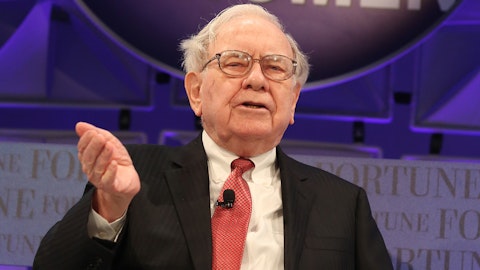T-Mobile US, Inc. (NASDAQ:TMUS) Q2 2023 Earnings Call Transcript July 27, 2023
T-Mobile US, Inc. misses on earnings expectations. Reported EPS is $1.43 EPS, expectations were $1.7.
Operator: [Starts Abruptly] [Operator Instructions] I would now like to turn the conference over to Mr. Jud Henry, Senior Vice President and Head of Investor Relations for T-Mobile US. Please go ahead, sir.
Jud Henry: Welcome to T-Mobile’s second quarter 2023 earnings call. Joining me on the call today are Mike Sievert, our President and CEO; Peter Osvaldik, our CFO; as well as other members of the senior leadership team. During this call, we will make forward-looking statements, which involve risks and uncertainties that may cause actual results to differ materially from our forward-looking statements. We provide a comprehensive list of risk factors in our SEC filings, which I encourage you to review. Our earnings release, investor back book and other documents related to our results, as well as reconciliations between GAAP and the non-GAAP results discussed on this call can be found in the Quarterly Results section of the Investor Relations website. With that, let me turn it over to Mike.
Mike Sievert: Okay. Thanks, Jud. Hi, everybody. Welcome to the call. As you can see, we’re here with several members of our senior management team. We’re coming to you live from Bellevue, Washington and we’re ready to take your questions. But first, let me share just a few comments. If you’ll recall at our Analyst Day in early 2021, we shared our strategy to build the best network, couple it with a leading un-carrier value proposition and customer experience and grow our share in areas where T-Mobile was massively underpenetrated relative to our peers. That strategy and our approach has remained remarkably consistent and our Q2 results continue to show that it’s working better than ever. In fact, T-Mobile delivered our highest Q2 postpaid phone net adds in eight years, fueled by both industry leading gross adds and the lowest postpaid phone churn in company history.
And importantly, we did this while industry growth normalized, proving that the growth opportunities and durable advantages we’ve been sharing with you really are unique to T-Mobile. We also told you that if we delivered the best product and the best value and the best experiences, there was no reason we couldn’t get to the lowest churn in the industry, remember that. And in Q2, we did it. For the first time in our history, T-Mobile reported the lowest postpaid phone churn in the industry. That is a remarkable statement and it’s a testament to the work our team has done to build the best network. And to further our value proposition to deliver even better experiences to customers. Now I’m sure there’s still going to be some back and forth between us and the other guys before we consistently put them in the rearview mirror for good on churn, but all the same, it is great to get this first win.
We also continue to run the business in a smart and sustainable manner, translating our industry leading customer growth in Q2 into industry leading service revenue growth and core adjusted EBITDA growth, while growing free cash flow by more than 60% year-over-year. This industry leading customer and financial growth led us to raise guidance for the year again. And we’re fortunate to deliver these industry leading results within the context of a vibrant wireless industry, with growing industry service revenues and industry cash flows and healthy competition that continues to deliver more value and better networks to customers. In fact, on network, we not only defended, but extended our leadership in both overall and 5G performance. With the latest third-party reports showing that T-Mobile’s lead is widening.
Looking at Ookla data. T-Mobile once again swept every category for overall network performance with median download speeds, more than double our closest competitor. We’ve long talked about how our dedicated 5G spectrum assets with superior propagation would result in a demonstrable advantage in customers’ everyday lived experiences even as the competitors try to catch us. T-Mobile’s head start, our dedicated 5G spectrum assets and our technology leadership are the things that allow us to stay meaningfully ahead as in like two years or more ahead in 5G reach and overall network performance and to stay ahead for years to come. And the most exciting part is that many prospective customers are only just beginning to notice, which means lots of the benefit from this is in front of us.
And importantly, these things also allow it to do it all with the best capital efficiency in the industry. Now we also continue to build on our fame for providing the best value. Our latest un-carrier move Phone Freedom, freeze customers locked up into those 3-year contracts at the carriers. And our new go 5G plus rate plan delivers the best value in wireless. The response from customers has been really amazing. In fact, Go5G Plus instantly became our most popular plan, and we’re seeing improved porting ratios against every competitor including yet another quarter of year-over-year improvement against cable. In fact, total postpaid porting ratios for us have improved every month since we launched Phone Freedom including in July. As more and more customers learn that they can break free from those three-year contracts come to a better network and get a better value at T-Mobile.
All of these catalysts, coupled with our unique growth opportunities in underpenetrated markets are what enable a differentiated and profitable growth strategy that separates us from the competition and you’re seeing it again in these Q2 results. We added 299,000 postpaid account net adds, the highest reported in the industry showing that we continue to win the switching decisions in the market. And we had postpaid net additions of 1.6 million again leading the industry by a wide margin. This included postpaid phone net adds of 760,000, our highest Q2 in eight years, even as the industry sees more normalized levels of growth. Our increased share was driven by our industry best phone gross adds, which grew over last year’s Q2 as well as the lowest postpaid phone churn in our history.
And as I mentioned, the lowest in the industry for the first time ever at just 0.77%. In T-Mobile for Business, we had a record quarter with best ever phone net adds and our lowest ever phone churn. Enterprise and government customers buy based on their own rigorous testing of the networks, not just price, and our network leadership, innovative solutions and customer experiences are driving major wins and fueling our momentum in these segments. We’re attracting profitable customers with CLVs in the hundreds of dollars each and still growing. As I mentioned, consumers are beginning to take notice of our network strides as well, as we’re winning prime network seekers in the top 100 markets who increasingly recognize that T-Mobile offers the best combination of network coverage and capacity to meet their needs.

Copyright: bluebay / 123RF Stock Photo
We saw our share of switchers in the top 100 markets increase both sequentially and year-over-year. In smaller markets and rural areas, where we continue to bring the first and in many places, only 5G network, we’re seeing an incredible response. We’re capturing a win share of switchers in these areas in the upper 30s, which shows we’re not only on track to meet our goal of 20% share in 2025, but it gives us confidence we have room to run in the years beyond. In addition to mobile wireless, we added 509,000 high speed Internet customers. Notably, we’ve continued to grow our gross adds every quarter since we launched over two years ago as demand for the product just continues to grow. And we saw a sequential improvement in churn again this quarter and Net Promoter Scores that remain multiples higher than cable, demonstrating how our high speed Internet resonates with and satisfies an important target audience within this larger broadband market.
We also celebrated another major milestone in our Sprint merger integration as we are now substantially complete with both the billing migration and retail rationalization, well ahead of our year-end target. At every step of our integration journey, the customer has been our primary focus. As you know, this has allowed us to not only unlock synergies bigger and faster than expected, but also to deliver industry leading growth and record low churn at the same time. I could not be more proud of what our team has accomplished in this area. Okay. I’m going to wrap it up. We are pulling into the station halfway 2023 with great momentum. Our postpaid phone net adds year-to-date are right on track with last year, which was a growth record year for us.
We continue to extend our durable network and value leadership over the competition, which fuels our growth opportunities. And our profitable growth strategy continues to translate into the highest core adjusted EBITDA growth and year-to-date cash flow conversion in the industry. Listen, in our industry, change is a constant, but our team navigates it definitely with the customer as our North Star. And because of that, there has never been a more exciting time to be at T-Mobile. Okay. Peter, over to you to talk about our key financial highlights and an update on our guidance for 2023.
Peter Osvaldik: Absolutely. Thanks, Mike. Q2 was another quarter of best-in-class profitable growth, which underpins the updated guidance that I’ll share with you in a moment. It starts with the best postpaid service revenue growth in the industry, up over 5% year-over-year driven by continued increases in both postpaid accounts and postpaid ARPA. Our disciplined focus on profitability resulted in an 11% year-over-year increase in core adjusted EBITDA and we grew our core adjusted EBITDA margin by over 300 basis points year-over-year. In addition, free cash flow was up 64% year-over-year and with the highest free cash flow to service revenue margin relative to our peers year-to-date. We expect this to be a durable and differentiated unlock of shareholder value going forward.
This strong financial performance also supported our share buybacks as we repurchased 25.2 million shares for $3.5 billion in Q2 with a cumulative total of 83.5 million shares repurchased for $11.8 billion as of July 21. All right. Let’s jump into the details of our increased guidance for 2023. We now expect total postpaid net customer additions to be between 5.6 million and 5.9 million, up 250,000 at the midpoint, reflecting growth across all of our market opportunities and we continue to expect roughly half of postpaid net adds coming from phones for the full year. Our focus on profitable growth allows us to fund those higher customer net adds and still increase our core adjusted EBITDA expectation, which we now expect to be between $28.9 billion and $29.2 billion.
This is up 10% year-over-year at the midpoint based on higher service revenues and merger synergies and excludes leasing revenues of approximately $300 million as we transition substantially all remaining customers off device leasing by year-end. Our merger synergies are expected to be approximately $7.5 billion in 2023, achieving the full run rate synergy target provided at our Analyst Day a year ahead of schedule as we build towards the full run rate synergies of $8 billion in 2024. We continue to expect merger related costs, which are not included in adjusted or core adjusted EBITDA to be approximately $1 billion before taxes. And we now expect cash merger related costs of $1.6 billion to $2 billion for 2023 as they have underrun the P&L recognition to date.
Net cash provided by operating activities, which include payments for merger related costs is now expected to be in the range of $18 billion to $18.3 billion and we now expect cash CapEx to be between $9.5 billion and $9.7 billion delivering a capital efficiency unmatched in our industry, unlocked by our network leadership. We expect CapEx to taper in Q3 and then further in Q4. The slightly higher operating cash flows fund the increased CapEx resulting in strong free cash flow of $13.2 billion to $13.6 billion, which includes payments for merger-related costs. This is up approximately 75% over last year, thanks to our margin expansion and capital efficiency and does not assume any material net cash inflows from securitization. This also represents a free cash flow to service revenue margin, which is multiple percentage points higher than peers with further expansion expected next year.
We continue to expect our full year effective tax rate to be between 24% and 26%. And finally, we now expect full year postpaid ARPA to increase slightly more than the 1% we had previously guided for 2023 as we continue to expand our account relationships across products and services as part of our land and expand account strategy to grow service revenue. Before I wrap up, I want to remind folks that we closed the sale of our wireline assets to Cogent on May 1, which had a partial impact on our results in Q2 and we expect the full run rate impact beginning in Q3 as I laid out last quarter. In closing, we continue to extend our network leadership and further scale our differentiated profitable growth opportunities to deliver the highest free cash flow conversion in the industry and unlock shareholder value.
And with that, I will now turn the call back to Jud to begin the Q&A. Jud?
A – Jud Henry: All right. Let’s get to your questions. [Operator Instructions] We’ll start with a question on the phone. Operator, first question, please.
See also 20 Best States to Live in After Retirement and 15 Worst Countries in the World for Vegetarians.
Q&A Session
Follow T Mobile Usa (NYSE:TMUS)
Follow T Mobile Usa (NYSE:TMUS)
Operator: Certainly, thank you. That will come from the line of Brett Feldman with Goldman Sachs. Your line is open.
Jud Henry: Hi, Brett.
Brett Feldman: Thanks for taking the question. And it was great to see — great to see the strong cash flow in the quarter. In light of that, we’ve gotten a few questions around why you decided to downtick a little bit on the buyback. And I guess maybe the higher level question we’re getting now that you’re much further into the program. How do you think about managing that program going forward? I mean cash flow is obviously an input. You’re going to be making some payments for C-band spectrum this year. So what’s the right way for investors to kind of frame your expectations around how you’re going to manage that on a go-forward basis? Thank you.
Mike Sievert: That sounds great. Thanks, Brett. I’ll start and then maybe hand it to Peter for some comments. The way I think about it is, we’re buying at a pace through — mostly through predesigned 10b5-1 programs in order to be able to meet the authorization during the time frame of the authorization. So if you recall, the initial authorization of this program is a $14 billion program that takes us through September. And if you look at some of our activity early in the year where we were able to grab some additional run rate. Now the remaining funds relative to the remaining time suggests a run rate where we have it. So it’s not really a downtick so much as just kind of a programmatic view. And then — and maybe Peter can pile in on the second part.
The way we think about it broadly is that there’s essentially been no underlying change to the thesis we’ve been communicating all along. Now our Board hasn’t made a determination yet about the second step, but the inputs to those steps have to do with the free cash flow development of this company, which, as you mentioned in the premise of your question is right on track. We’re guiding to 75% year-over-year cash flow growth this year. And the underpinnings of the growth in the business, as you saw from our fantastic Q2 momentum suggests another good year in ’24. And so — as the cash flow develops, that’s what gives us the confidence that, that original thesis of around $60 billion through 2025 is intact. But maybe you can also comment, Peter, on kind of how we think about this from a dedication of resources to this versus spectrum and other things as Brett asked.
Peter Osvaldik: Yeah. Absolutely, Brett. One of the things that we had underpinned at Analyst Day is that it’s up to $65 billion of free cash flow that’s going to support the $60 billion of potential shareholder remuneration. And within that, we had some room and had reserved some capacity for spectrum purchases and other things. And of course, we’ll fundamentally continue throughout this whole period, one to deliver because the underlying delivery of the free cash flow is what allows everything to happen. And, of course, always look at opportunities before us for the highest value creation opportunity. With your question on C-band, that was already included in our assumption here. So when we continue to say, we have optimism around the program in totality, C-band is fully contemplated within that.
Brett Feldman: That’s great color. If I can ask a quick follow-up question as we’re talking about overall liquidity. Any update on the spectrum option that DISH hold and if that were to get exercised, how do you think about putting that proceeds to work? Thanks.




